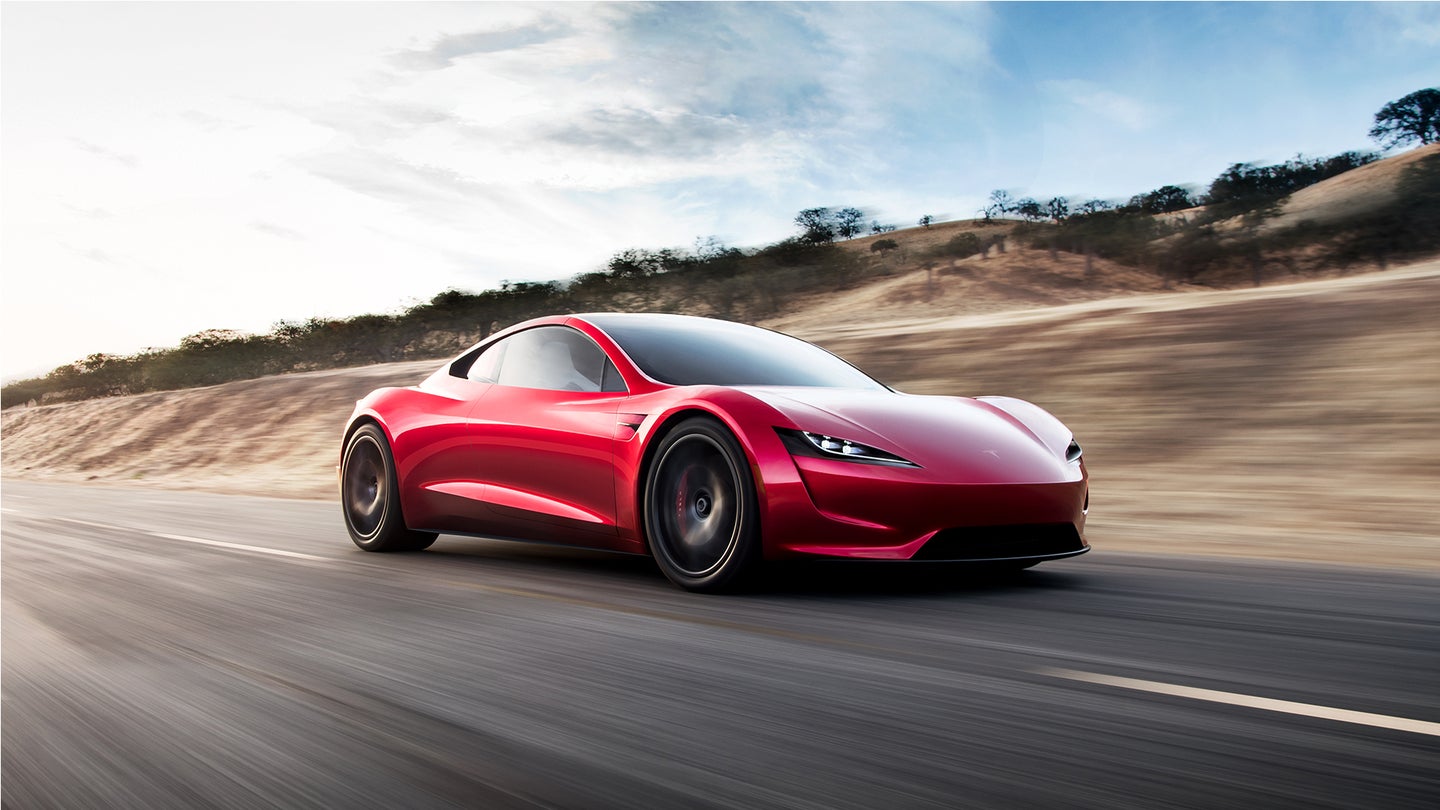Science Confirms: New Tesla Roadster Will Be the Greatest Getaway Car Ever
We wanted to know how long the Roadster can sustain 250 mph. We have our answer.

You’ve just robbed a bank in Los Angeles, the cops are bearing down on you from all sides, and you need to get out of the country pronto. Mexico it is. In the alley behind the bank sits a $3 million Bugatti Chiron hypercar and a $200,000 Tesla Roadster electric sportscar. Both can reach a top speed of 250 miles per hour. Assuming the highways at are free and clear (I know, I know, it’s just a thought experiment) which vehicle do you choose to make your getaway?
If the calculations executed by the engineers at Carnegie Mellon’s Department of Mechanical Engineering are correct—and they usually are—the Roadster is the way to go, by far. The reason: With the throttle pinned, it’ll leave the Boog by the side of the road.
Assistant Professor Venkat Viswanathan and graduate researcher Shashank Sripad, both experts in battery-electric vehicle technology and veteran critics of Tesla’s preliminary performance claims, spent some time this weekend crunching the available numbers for us on the new Roadster in order to predict the totality of its capabilities. Working from the scant data provided by Tesla CEO Elon Musk during the unveiling last week—including 0-60 mph and 0-100 mph data, with the key gaps being the car’s total weight and it aerodynamics—the scientists were able to pull together a compelling Roadsterpedia for the new machine to entice our imaginations.
To start, the Roadster will have a powerful 200 kWh battery and a range of 620 miles, according to Tesla’s announcement. What can you start to learn from that? A lot about the vehicle’s weight, for one thing. “This is very close to the watt-hour per mile of a Model S sedan,” Sripad says, noting that the Model S packs a 100 kWh battery—half that of the Roadster—in its most aggressive performance trim. “But the Roadster has much better aerodynamics, as claimed by Tesla’s website, so the Roadster's weight must be similar to or higher than the Model S.”
They also note that the Tesla Model 3 compact sedan has an 80 kWh battery pack that weighs about 480kg. The engineers assume that Tesla has produced an additional 20 percent improvement in the pack’s specific energy, probably due to better packaging materials. (Their reasoning there is that improvements of that magnitude in the chemistry of the battery itself is very difficult, and not yet feasible.) So the Roadster’s battery pack likely weighs between 1,980 and 2,200 pounds, and the whole vehicle around 4,400 pounds, assuming the battery pack takes up about 45 to 50 percent of the total vehicle weight.
In terms of performance capabilities from the Roadster’s battery, the key metric to watch is “normalized discharge current,” or C-rate, which helps estimate how much power the battery cells are capable of providing and how fast. “Each cell has a given capacity, and the C-rate at a given discharge current equals the current normalized by cell capacity,” Sripad explains. “So C-rate tells you how much ‘discharge stress’ each cell undergoes.”
To reach the claimed 0-60 time of 1.9 seconds, for the Roadster would need a much lower C-rate compared to a Model S P100D—the current top-performing Tesla sedan—in order to distribute as much power as possible to the car’s electric motors. The Roadster will have twice the battery capacity, thus half the C-rate. (That is, it won’t have to work as hard to generate power as the smaller battery pack in the P100D.) So the Roadster can get to 60mph faster than a P100D because it has more cells to draw power from. To get to 100 mph in 4.2 seconds, the Roadster uses similar C-rates that the P100D uses to get to 60 in 2.5 seconds. In short the Roadster’s battery in “Plaid mode”—its fastest guise—will draw current at roughly the same rate as the P100D in Ludicrous mode, its own top end. Plus, it’ll likely generate close to 1,500 HP to do it, compared to the P100D’s 760 HP.
So what does this all mean in terms of choosing our getaway vehicle? The vehicle dynamics model Viswanathan and Sripad developed based on the battery capacity, the car’s weight, and its known performance data suggest that the Roadster is capable of maintaining 250 mph for between 25 and 30 minutes. A Bugatti Chiron, on the other hand, would run out of fuel in its 22-gallon tank at the same top speed in just 9 minutes. So leaving downtown Los Angeles, the Boog will peter out after just 38 miles—a bit more if running at its claimed top speed of 261 mph, which the Roadster can possibly equal. That’ll put it somewhere near Irvine, while the Roadster can make it about 130 miles, or all the way to the border, before running out of juice.
Interesting side note: The new Roadster’s performance precisely doubles that of its predecessor, the Tesla Roadster manufactured between 2008 and 2012 and based on the Lotus Elise chassis. Acceleration jumps from a 0-60 time of 3.9 seconds to 1.9, while top speed goes from 125 mph to 250 mph. (Pricing also doubles quite neatly, from a base of $100,000 to a base of $200,000.) Using similar logic, the original Roadster could sustain its modest top speed of 125 mph for about 15 minutes, Sripad says, meaning it would get about as far as Disneyland before the cops caught up.
